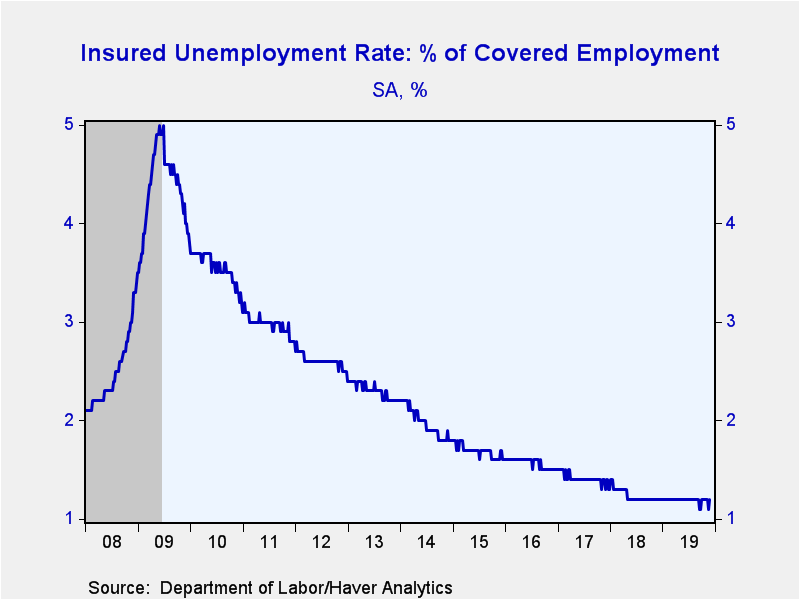 Global| Dec 05 2019
Global| Dec 05 2019U.S. Initial Claims for Unemployment Insurance Fall to 7-Month Low
Summary
Initial claims for unemployment insurance fell 10,000 to 203,000 (-11.4% y/y) during the week ending November 30. The previous week was unrevised at 213,000. This was the smallest amount since 193,000 in the April 13 week. The Action [...]
Initial claims for unemployment insurance fell 10,000 to 203,000 (-11.4% y/y) during the week ending November 30. The previous week was unrevised at 213,000. This was the smallest amount since 193,000 in the April 13 week. The Action Economics Forecast Survey expected a slight increase to 216,000 claims. The four-week moving average of initial claims declined to 217,750 from 219,750 the week before. The Thanksgiving holiday came, of course, during this week and could well have impacted the number of claimants; the holiday occurs on the fourth Thursday of November and was as late this year as it can be, likely affecting the seasonal adjustment calculations.
Continuing claims for unemployment insurance rose 51,000 to 1.693 million (+2.4% y/y) in the week ended November 23, thus returning to the range of the previous several weeks. The November 16 number was revised modestly upward by 2,000 to 1.642 million. The four-week moving average of claimants was unchanged at 1.681 million.
The insured rate of unemployment rose to 1.2% in the November 23rd week, up from the record-low of 1.1%. It thus returned to its long-standing amount, a number first seen in May 2018. Data on the insured unemployment rate go back to 1971.
Insured rates of unemployment vary widely by state. During the week ending November 16, the lowest rates were in Nebraska (0.26%), South Dakota (0.31%), Florida (0.42%), North Carolina (0.45%) and New Hampshire (0.46%). The highest rates were in Connecticut (1.63%), California (1.70%), West Virginia (1.70%), New Jersey (1.99%), and Alaska (2.78%). Among the other largest states by population not mentioned above the rate was 0.99% in Texas, and 1.33% in New York. These state data are not seasonally adjusted, thus Alaska has particularly large seasonal swings in insured rates of unemployment.
Data on weekly unemployment claims going back to 1967 are contained in Haver's WEEKLY database, and they are summarized monthly in USECON. Data for individual states are in REGIONW. The expectations figure is from the Action Economics Forecast Survey, carried in the AS1REPNA database.
| Unemployment Insurance (SA, 000s) | 11/30/19 | 11/23/19 | 11/16/19 | Y/Y % | 2018 | 2017 | 2016 |
|---|---|---|---|---|---|---|---|
| Initial Claims | 203 | 213 | 228 | -11.4 | 220 | 244 | 262 |
| Continuing Claims | -- | 1,693 | 1,642 | 2.4 | 1,756 | 1,961 | 2,135 |
| Insured Unemployment Rate (%) | -- | 1.2 | 1.1 |
1.2 |
1.2 | 1.4 | 1.6 |
Carol Stone, CBE
AuthorMore in Author Profile »Carol Stone, CBE came to Haver Analytics in 2003 following more than 35 years as a financial market economist at major Wall Street financial institutions, most especially Merrill Lynch and Nomura Securities. She has broad experience in analysis and forecasting of flow-of-funds accounts, the federal budget and Federal Reserve operations. At Nomura Securites, among other duties, she developed various indicator forecasting tools and edited a daily global publication produced in London and New York for readers in Tokyo. At Haver Analytics, Carol is a member of the Research Department, aiding database managers with research and documentation efforts, as well as posting commentary on select economic reports. In addition, she conducts Ways-of-the-World, a blog on economic issues for an Episcopal-Church-affiliated website, The Geranium Farm. During her career, Carol served as an officer of the Money Marketeers and the Downtown Economists Club. She has a PhD from NYU's Stern School of Business. She lives in Brooklyn, New York, and has a weekend home on Long Island.









